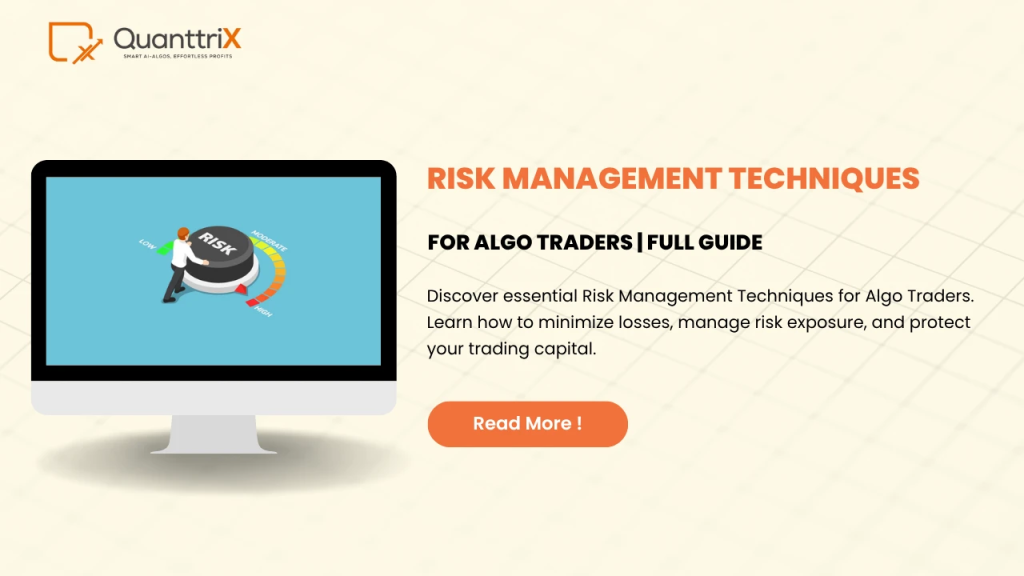Risk Management Techniques for Algo Traders
Introduction
Are you intrigued by the idea of trading algorithms making smart financial decisions on your behalf? If you’re considering stepping into the world of algo trading or already dabbling in it, understanding risk management is crucial. Think of trading algorithms like boats sailing in the vast seas of the stock market—it’s all about navigating through storms without sinking. This article will walk you through essential risk management techniques tailored for Algo Traders, using simple language anyone can follow.
Learn key risk management techniques for Algo Traders using trading algorithm and best algorithmic trading software India.
What is Algo Trading?
Algorithmic trading, or algo trading, means using computers programmed to follow a set of rules to buy or sell assets at the right time. Instead of human emotions, decisions are based on data and trends. Imagine a highly efficient robot trader—calm, precise, and lightning fast.
Why Risk Management is Vital in Algo Trading
Even with the smartest trading algorithm, the market can be unpredictable. Without proper risk controls, losses can pile up quickly. Risk management acts like a safety net, preserving your capital so that your trading boat stays afloat no matter how wild the market waves get.
Understanding Trading Algorithm Basics
A trading algorithm uses mathematical models to decide entry and exit points. The design includes criteria for buying, selling, and risk controls. The more robust and tested the algorithm, the better it handles market fluctuations.
Setting Risk Limits: The First Line of Defense
Start by defining how much of your total capital you’re willing to risk on any single trade or day. For example, risking only 1-2% of your funds per trade limits damage if a trade doesn’t go your way.
Position Sizing: Managing Exposure
Position sizing means deciding how many units or shares to buy or sell. Bigger positions mean bigger risks. A good algorithm calculates position size based on both your risk tolerance and market volatility, keeping you safe like a seatbelt in a car.
Stop Loss Orders: Protecting Your Investment
Stop loss orders automatically close a losing trade at a pre-set price. This prevents small losses from ballooning into catastrophic ones. Think of it as your algorithm’s emergency brake.
Diversification: Not Putting All Eggs in One Basket
Spreading trades across different assets or markets can reduce risk. If one area tanks, others may hold firm, balancing out losses with gains.
Backtesting and Forward Testing: Checking Reliability
Before running an algorithm live, testing it on past market data (backtesting) and simulated live data (forward testing) reveals how it would perform. This helps weed out flaws and manage risks before real money is on the line.
Real-time Monitoring and Alerts
Even automated systems need human eyes. Monitoring trades and setting alerts for unusual activity or market events helps intervene when needed and ensures the algorithm behaves as intended.
Using Trailing Stops for Locking Profits
Trailing stops adjust the stop loss level as the price moves in your favor, locking in profits while still allowing for upside potential. It’s like having a smart guard that tightens controls as you gain.
Handling Slippage and Latency Risks
Slippage happens when a trade executes at a different price than expected; latency refers to delays in order execution. Both can increase costs or losses. Using advanced trading software with minimal latency and efficient execution helps reduce these risks.
Scaling In and Out of Positions
Instead of making big trades at once, scaling lets you enter or exit positions gradually. This reduces impact on the market price and limits risk on sudden moves.
Emotional Control with Automated Trading
One advantage of algo trading is removing emotional bias. Robots don’t fear or get greedy. Sticking to your pre-set rules, especially in volatile markets, prevents costly emotional mistakes.
Choosing the Best Algorithmic Trading Software India
Selecting the right software is key. Look for platforms that offer real-time data, risk management tools, easy backtesting, and low latency execution with strong customer support to help navigate your trading journey confidently.
Continual Review and Adaptation
Markets evolve, and so should your trading algorithm. Regularly reviewing performance and updating parameters ensures your risk management stays sharp and your strategy effective.
Conclusion
Risk management is the lifeline of successful algo trading. By setting clear limits, diversifying, using stop losses, monitoring regularly, and choosing the right software, you create a robust defense against market unpredictability. Think of it as equipping your trading boat with the best navigation and safety gear to sail smoothly through rough seas. Whether you’re just starting or looking to improve, these techniques keep your investments safe and your mind at ease.
FAQs
1. What is the most important risk management technique for algo traders?
Position sizing and setting stop-loss orders are crucial as they directly control how much you can lose on a trade.
2. Can algorithmic trading eliminate all risks?
No, it minimizes but does not eliminate risks. Market conditions can change rapidly and unpredictably.
3. How often should I review my trading algorithm?
Regular reviews every few months are recommended or sooner if market conditions change drastically.
4. Why is backtesting necessary?
Backtesting shows how your algorithm would have performed in the past, helping identify potential weaknesses before risking real money.
5. Which is the best algorithmic trading software in India?
The best software depends on your needs, but look for ones with real-time data, risk management features, and strong execution like Quanttrix or AlgoTrader.







